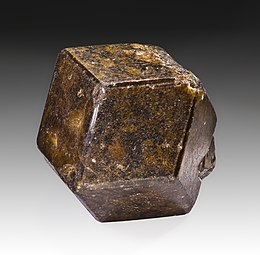| Andradite [Adr] | |
|---|---|
 Single crystal (4.2 cm) – Diakon, Nioro du Sahel Circle, Kayes Region, Mali | |
| General | |
| Category | Garnet group |
| Formula (repeating unit) | Ca3Fe2(SiO4)3 |
| IMA symbol | Adr[1] |
| Strunz classification | 9.AD.25 |
| Crystal system | Cubic |
| Crystal class | Hexoctahedral (m3m) H-M symbol: (4/m 3 2/m) |
| Space group | Ia3d |
| Unit cell | a = 12.056 Å; Z = 8 |
| Identification | |
| Color | Yellow, greenish yellow to emerald-green, dark green; brown, brownish red, brownish yellow; grayish black, black; may be sectored |
| Crystal habit | Commonly well-crystallized dodecahedra, trapezohedra, or combinations, also granular to massive |
| Cleavage | none |
| Fracture | conchoidal to uneven |
| Tenacity | Brittle |
| Mohs scale hardness | 6.5 to 7 |
| Luster | Adamantine to resinous, dull |
| Streak | White |
| Diaphaneity | Transparent to translucent |
| Specific gravity | 3.859 calculated; 3.8–3.9 measured |
| Optical properties | Isotropic, typically weakly anisotropic |
| Refractive index | n = 1.887 |
| Absorption spectra | demantoid – 440 nm band or complete absorption at 440 nm and below, may also have lines at 618, 634, 685, 690 nm[2] |
| References | [2][3][4][5] |
| Major varieties | |
| Demantoid | transparent light to dark green to yellow-green |
| Melanite | opaque black |
| Topazolite | transparent to translucent yellow, may show chatoyancy |
Andradite is a mineral species of the garnet group. It is a nesosilicate, with formula Ca3Fe2Si3O12.
Andradite includes three varieties:
- Melanite: Black in color due to limited substitution of titanium for iron. Also known as "titanian andradite". Forms a solid solution with morimotoite and schorlomite depending on titanium and iron content.[6]
- Demantoid: Vivid green in color, one of the most valuable and rare stones in the gemological world.[7]
- Topazolite: Yellow-green in color and sometimes of high enough quality to be cut into a faceted gemstone, it is rarer than demantoid.[7]
It was first described in 1868 for an occurrence in Drammen, Buskerud, Norway.[3][4][7] Andradite was named after the Brazilian statesman, naturalist, professor and poet José Bonifácio de Andrada e Silva (1763–1838).[3][7]
